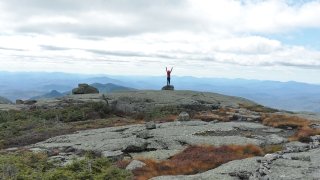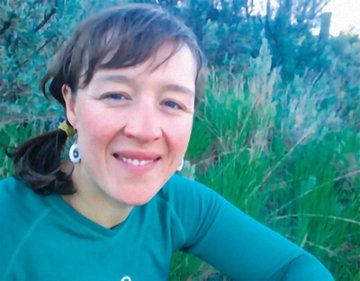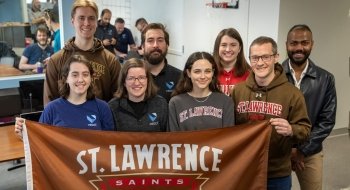
St. Lawrence reflects on two decades of living and learning in the Adirondacks.
If someone told me I’d get a second chance (and a third, fourth, and fifth) to participate in the Adirondack Semester, 13 years after my first go-round as a shy sophomore at St. Lawrence University, I would never have believed them—not in a million years.
Soon after graduating from St. Lawrence in the spring of 2006, I drove, by myself, across the country to California. I lived out West for the next 10 years. My time as an undergraduate at the small liberal arts school atop the shoulder of New York state sat on a quiet shelf in the back corners of my brain, slowly collecting dust and fading out behind new experiences and places. For many college graduates, this is how it goes.
I first enrolled in the Adirondack Semester as a student in the fall of 2003, a program in its fourth year at the time. My classmates and I were the third group of students to live at Arcadia, a village of eight or so yurts nestled on the shores of Massawepie Lake—not a place you can locate on Google Maps, even today. Massawepie is ensconced by a roughly 4,000-acre conservation easement managed by the Boy Scouts of America and located in the northwest corner of the Adirondack Park, about a 90-minute drive from campus, with an additional mile hike to access the site.
The inaugural ADK Semester was held at an aging Boy Scouts’ lodge on the easement, not far from the waters of Massawepie. However, due to challenges of living in the aging structure and the desire to create a truer wilderness experience, the program was moved to a remote site across the lake, accessible only by boat or foot.

Arcadia, still the home base of the Adirondack Semester today, has several small solar panels to power lights, a refrigerator, and a fan in the composting toilet. There is a propane stove for cooking. In 2003, we conveniently hand-pumped our water from a well; today, we haul water in 5-gallon jerry cans about 100 yards from the front dock to the kitchen building, which was added in 2007. As we did during my semester, students canoe across the lake to attend woodworking classes and go on field trips.
Now in its 20th year, the Adirondack Semester program grew out of conversations that were had in the late 1990s—conversations among faculty and staff about how to define what “outdoor studies” actually meant. An optional minor at St. Lawrence, the Outdoor Studies program sought to combine aspects of living and traveling in natural settings with the academic scope and rigor of a liberal arts education, but it had a dynamic understanding at best.
“No one knew what outdoor studies was,” says Karl McKnight, the first director of the Adirondack Semester and a part of the initial group of faculty and staff who dreamt the program into being. “It was [a] foggy, mystical thing, not really science, activism, ecology, or art.”
Cathy Shrady, director of the program since 2010, and a part of the initial group of faculty and staff brainstorming, recalls that the impetus for the Adirondack Semester was “[an appreciation of] the power of place-based, immersive education in an outdoor setting.” The Adirondack Park, the northern border of which lies less than 25 miles south of the St. Lawrence campus, seemed like the perfect place to set this new and unprecedented program in motion. According to McKnight, it was modeled after St. Lawrence’s study abroad programs, the idea being to “build a program abroad in nature.”
Back in 2003, the semester commenced in mid-August at Catamount Lodge, a property owned, at the time, by the University, located about halfway between the St. Lawrence campus and Massawepie Lake. The two assistant directors of the semester, Rick and Julie, would be leading us on a 10-day canoe expedition on the Petawawa River in eastern Ontario to kick off the semester.
Julie laid out the clothes she was going to take with her on the canoe trip as an example for us to follow. She had one set of long underwear, a top and a bottom. She had shorts, wind pants, a polypropylene T-shirt, a fleece jacket, a rain jacket, and not much else. I thought she was crazy and packed an extra shirt and pants, neither of which I ended up wearing.
The first time I slept outside of a tent was on the Petawawa trip. I laid my Thermarest on the bare ground and my sleeping bag inches from dirt and pine needles. The air and the sky were so vast and open over my head; I could barely sleep in all that space. I always think of the Mary Oliver poem “Sleeping in the Forest” when I remember it:
All night
I heard the small kingdoms breathing around me,
the insects, and the birds
who do their work in the darkness. All night
I rose and fell, as if in water, grappling
with a luminous doom. By morning
I had vanished at least a dozen times
into something better.
I can’t describe what it was like better than that.
Today, the canoe trip traverses the waterways in the Adirondack Park, and the group paddles straight to Arcadia (albeit via several canoe carries, or “portages,” along the way). The final day of the trip can be grueling. The route diverges from the Raquette River and travels up Dead Creek, just outside of Tupper Lake.
Dead Creek is not often (and quite possibly, not at all) paddled by recreational boaters. It is narrow, less than five feet wide in some spots, and zigzags left and right. While the section we paddle is only about three miles long as the crow flies, the route is several miles longer due to its twists and turns. It is also full of beaver dams that paddlers must haul their canoes and themselves up and over.
Eventually, the creek goes under a bridge, where we take out. There, we hike our longest portage of the trip, a little over two miles up and over an “esker,” a long mound of sand and sediment left behind by glaciers. By this point, the students have had ample practice shouldering their canoes and dry bags, and they are mostly ready for it.
Finally, we crest the hump of the esker, and we see Massawepie Lake glimmering in the sun through the trees. We plop our boats in the water and paddle home for the first time of many. Several students have told me that first moment laying eyes on Arcadia—having arrived at the front dock via canoe and having traveled 60 miles give or take, over water through the Adirondacks—is one they will never forget.
We move out of Arcadia at Thanksgiving break. The yurts are not insulated for winter weather, and inevitably it snows before the end of October. The lake begins to freeze. As the days grow shorter and colder, life at Arcadia, predictably, gets harder. According to McKnight, these conditions breed poor students.
During the early years of the program, up until the fall of 2006, the students would travel to the southwest United States for the last two weeks of the semester, to compare and contrast the Chihuahuan Desert with the Adirondack Park. “What better way to understand the wet and the cold [environment of the Adirondacks] than with the dry and the hot?” asks McKnight.
As part of our ecology class in 2003, taught by McKnight, we traveled to Big Bend National Park in southwestern Texas. Prior to the trip, I’d never been south of Massachusetts or west of Ohio. I’d spent my entire life among the dense green forests, rushing creeks, and granite-topped mountains of the Northeast.
We boarded a plane in New York in the beginning of December, enduring the gray sky, bare branches, and a frigid wind. We landed in El Paso, Texas, and were greeted by the sun and the dusty, dry air. It didn’t take long for civilization to fade as we drove east towards Big Bend.
The sky turned purple-blue and the air cooled. Tumbleweed rolled across the highway, just like in the movies. Miles away from any towns or houses, we saw a man wearing a straw hat, riding a donkey along the side of the highway. It seemed that cattle roamed free everywhere; we almost hit one standing in the middle of the road with its rump toward us after dark, a black dot quickly growing in the headlights.
In the Adirondacks, McKnight had enthralled us with slime molds, glacial moraines, and eskers. He now captivated us with spiny cacti and the colorful geology of ancient seas. Layers of earth were stacked on each other like pancakes, twisted and turned in wrenched folds. Black rock rubble from prehistoric volcanoes littered the ground. Cow skulls and bones sat half buried in sun-warmed sand.
From that hot, dusty vantage point way south and west of where we’d spent the last three months, we looked back at the Adirondacks, so very opposite of the desert, in awe. Different latitudes, longitudes, altitudes, and proximities to water create vastly different climates. Plants and animals adapt and evolve in extraordinarily creative ways—as do we, and as did the Adirondack Semester itself.
Since 2007, the program has become much more locally focused. The canoe trip was relocated to the Adirondacks to take advantage of the hundreds of miles of waterways flowing through them. Eating local, sustainably grown food has also become an integral aspect of the program. After Thanksgiving break, students now go on internships with local farms and businesses, to both get an even deeper feel for the nature and culture of the Adirondacks, as well as to try and make sense of their experience living in a small community well off the grid and well away from their cell phones and computers.
Although technology has vastly shifted since I was a student and the curriculum has evolved in many ways over the years, the learning outcomes of living at Arcadia remain the same. I’ve learned that it is not only possible, but inevitable, that you will get to know people, as well as landscapes and waterways, deeply, just by spending time together in dialogue and in silence.
The job for assistant director of the Adirondack Semester opened up as I was finishing my last semester of graduate school at the University of Montana in Missoula. In the eight years between graduating from St. Lawrence and attending the University of Montana, I had worked as an environmental educator, barista, wilderness trip leader, and EMT, among other odd jobs. I had accrued two years worth of days in the field, living out of a dry bag or a backpack, traveling hundreds of miles over land and water, all the while teaching college students how to do the same before I applied to return to St. Lawrence.
The assistant director position required leading two wilderness trips, canoeing and backpacking, teaching a class called Modern Outdoor Recreation Ethics, and living on a remote site, off the grid, with the students. There wasn’t a more perfect job for what I’d always thought was a very random set of career skills and experiences.
I got the job, and now, each time a new semester begins, I am reminded of the first time I arrived at Catamount, unsure of what was ahead. Nobody ever looks as nervous to me as I remember feeling then, but I’m sure some are.
“This is what I wear during the day, on the water,” I explain, as I lay out my clothes on a ground cloth the same way Julie did back in 2003, pointing out my bathing suit, swim shorts, and light polypropylene shirt. “I keep my rain jacket and wind pants accessible in a small day bag, in case of bad weather,” I add, holding up a small, waterproof sack to keep items one may need periodically throughout the day, like sunscreen, water purification, and snacks, along with extra layers.
I move to my camp clothes, laid out as if a human recently vanished and left them behind: a wool hat, a small puffy jacket, thermal long underwear, wool socks, and lightweight camp shoes. I explain that these items get packed away in folks’ personal dry bags to be tied into the boats for the day. “This is like your check bag at the airport, and the day bag is your carry on,” I say.
After the packing demonstration, we examine each student’s gear to make sure each person has what is needed for the canoe expedition: not too much, not too little. Of course, we all bring things we don’t end up needing, and we forget things we wish we had. But like all beings, we adapt and evolve to our surroundings the best we can.
After 20 years, Shrady believes the Adirondack Semester is more relevant than ever for several reasons: changes in technology, the feelings of disconnection and divisive trends in communities, and the critical issue of climate change.
“During the Adirondack Semester, students take a step back from technology, especially social media, allowing space for self-reflection and informed decision making about technology use,” Shrady says. “They explore the simple pleasures and power of a sense of place and living in community. Through immersion in nature they learn to care deeply about the planet and their impact on it.
“Fostering perspectives such as these among those to whom the future is entrusted is why the Adirondack Semester is important,” Shrady concludes. “I can think of no brighter hope for the future than these students.”



